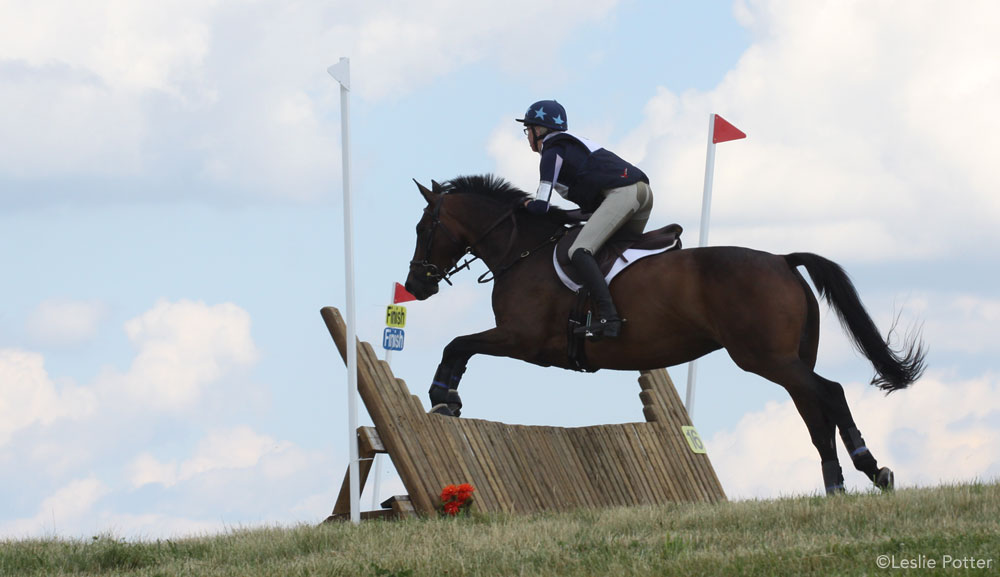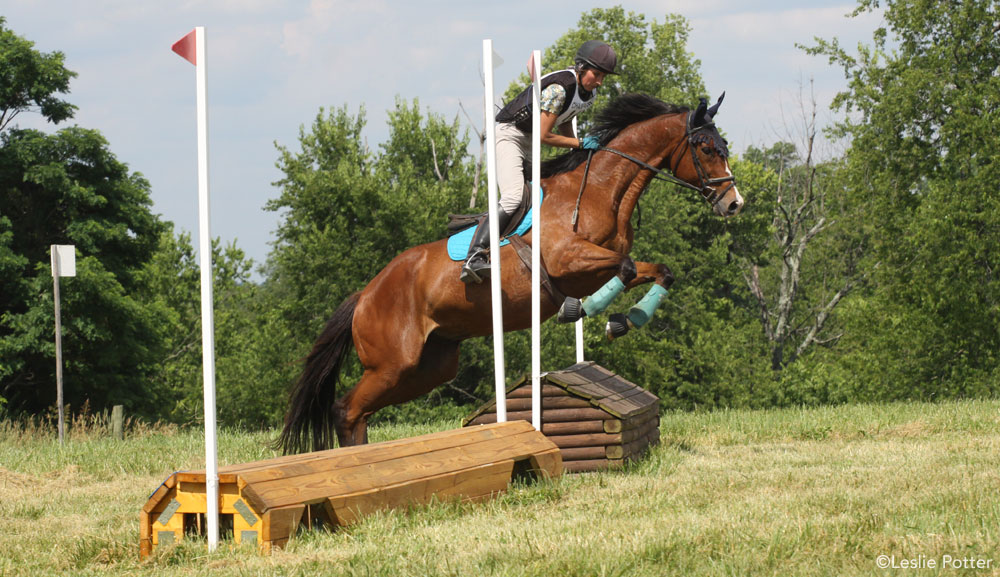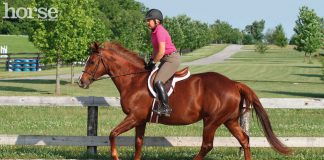Can you keep your horse on the bit through basic dressage movements? Is he comfortable negotiating difficult terrain while hacking out? Can he handle a course of small jumps with ease? If you answered yes to all three, you’ve probably considered eventing. If you’re not already involved in this exciting sport, here’s your chance to give it a try.

Beginner Novice jumps cannot exceed 2’7″—and that’s a big step down from the sport’s next level, Novice, where the jumps reach 2’11”. The Beginner Novice dressage tests ask for walk, trot, canter, with a figure no more demanding than a 20-meter circle, plus a required halt at the test’s conclusion. The cross-country course is short—about four minutes of moderate cantering—and offers 14 – 18 straightforward and inviting jumps, including a bank up, a water crossing and a shallow ditch. The show jumping test requires nine to 11 fences with only one two-stride combination allowed.
Does this sound like a challenge within your reach? As the USEA’s executive director Jo Whitehouse says, “We welcome everybody who in their hearts consider themselves eventers to give our sport a try.”
Not for Beginners
Despite the name, Beginner Novice is not actually intended for beginning riders. The USEA rulebook suggests that Beginner Novice is “designed for competitors and horses that have already had experience at schooling competitions in all three disciplines.”
Well-known event trainer and national and international eventing judge Jane Hamlin from Cornish, N.H., makes sure her riders have solid basic positions and are firmly in control outside arena walls before she lets them start cross-country work. “I want to see a rider canter from point A to point B in an open field before I throw a jump into the mix,” she says. “Control is always an issue. I want to see them ride safely off the manicured paths and work up and down slopes before we start cross-country work.”
One of the best ways to try out cross-country is to sign up for a hunter pace. Here you’ll ride a prescribed course through hunt country, jumping optional fences in a relaxed manner. Since a hunter pace isn’t judged, you can trot fences or even skip the ones you don’t feel ready for. Try to find a riding buddy with an experienced cross-country horse to guide you, so you’ll have a lead over any fence you feel nervous about.
Schooling Events
Events not recognized by the USEA—often called schooling events—offer a terrific educational challenge for would-be eventers. These can be found across the country and are often run by the same organizers who manage official USEA events.
One of these organizers is Laurie Hudson, who manages Hitching Post Farm in South Royalton, Vt. Laurie runs one recognized event in May but offers schooling shows throughout the summer at her farm.
“We run our schooling trials following the same rules and guidelines as recognized events,” Laurie says. “But things are a little more relaxed. It’s a great place for a first-timer.” The cost is usually slightly lower, too; unrecognized events often cost between $70 – $80, whereas most USEA event entries typically start around $110.
Penny and Brian Ross organize some of the sport’s most prestigious competitions, including this year’s North American Young Riders Championships, at the Virginia Horse Center in Lexington, Va. But the Rosses also run a series of low-key competitions with beginner schooling levels throughout the year—from pace events to unrecognized horse trials—often attracting 200 – 300 riders per outing.
“We give eventing newcomers the chance to ride over safe, well-designed fences and learn what the sport is all about in a fun yet educational way,” Penny says.
While schooling events offer an excellent opportunity for first-time event competitors, make sure that the unrecognized event you choose is run by reputable and knowledgeable individuals. Fran Cross from Southampton, Mass., who runs an unrecognized Beginner Novice division along with her USEA events, King Oak Farm Horse Trials, notes, “We’ve always put the same construction care and detail into our Beginner Novice cross-country jumps as we have our Novice fences,” she explains. “A Beginner Novice should never be simply a couple of logs strewn across a trail.”
Why Recognized?
So with schooling events flourishing, why did the USEA bring the Beginner Novice level into the fold?
“At many schooling events, organizers would set their own guidelines for jumping efforts—which means Beginner Novice at one place might be 2′ while another farm might offer a 2’6” course,” Jo Whitehouse explains. “Riders didn’t know what they were getting into.”
“Now the USEA has standardized the level, with fence dimensions clearly specified in the rulebook,” she continues. “USEA recognition means that licensed officials will evaluate courses, check footing and make sure the competition is run according to our standards.”

Beginner Novice is intended to be a step up from the lower levels you’ll experience at unrecognized/schooling shows.
That’s where the added expense comes, too—rated judges and trained officials come at a premium—and many of the USEA requirements, such as having a vet and farrier on the grounds, providing ambulance service, food concessions and even portable toilets do not come cheaply.
On the plus side, your USEA entry dollar buys a much more professional competition. The Beginner Novice division receives the same attention to detail as does the sport’s highest level, Advanced. “Recognition also means that Beginner Novice riders have the chance to aim for both national and regional year-end points, championships and awards,” Jo adds.
You don’t have to join USEA to compete in a recognized Beginner Novice event, but you must pay a $25 non-member fee with each entry. That payment, however, earns you a subscription to the organization’s magazine, Eventing USA. Should you decide to join USEA later in the season, any non-member fee payments will count toward the annual membership fee.
Cross-Country Preparation
The required speed for the Beginner Novice level cross-country is 300 to 350 meters per minute—a controlled canter as opposed to a gallop. Still, riders used to arena jumps on flat ground and perfect footing will find the notion of jumping fixed obstacles over varied terrain quite a challenge at first.
For many of Jane Hamlin’s students with showing backgrounds, a 2’6″ jump looks fine in the ring but becomes quite daunting when it’s a log pile in the middle of a field. “The hardest thing for so many riders to learn is, cross-country isn’t about one perfect position that you can practice endlessly,” she says.
Event riders do maintain a traditional two-point position when galloping between jumps. But for safety reasons, riders need to shift into a more secure position—shoulders back, seat bones in the saddle—on the approach to a solid cross-country fence. “You have to develop the suppleness to move with your horse, stay out of his way, yet remain in a safe balance,” Jane explains.
For neophyte eventers, learning to adopt a more centered position for cross-country jumping represents the biggest learning curve required by the sport. If your budget allows, seek out cross-country instruction from an experienced eventing professional before you start competing.
Rules of the Road
If you’ve never evented before, it makes sense to watch an event before you try riding in one. The USEA publishes “The Omnibus Schedule” four times a year, which lists entry information and specifics about recognized events nationwide. (Check out the USEA website for additional information.) If you’re ready to compete, remember that each event has an “opening date” for entries, six weeks prior to the competition; make sure your entry is postmarked on or after opening date. Events often fill up quickly, so try to get your entry in on time.
For the dressage and show jumping phases, you’ll need formal attire (black or navy show coat, white or tan breeches, boots, white shirt and stock tie). Cross-country attire is casual, but riders must wear a mandatory body protector and a medical armband.
Read the USEA rulebook to make sure you follow appropriate tack requirements. The rules specify which bits are allowed in each phase and explain what’s legal in warm-up, too. For example, you can warm up with a running martingale for dressage but it must be removed for the test; standing martingales are never allowed in any phase; and protective horse boots are allowed in warm-up but not in the dressage arena.
Even if you read the rulebook thoroughly, the sport’s many technicalities can overwhelm a new competitor. For example, your dressage test must be memorized and test “readers” are not permitted; warm-up fences are always flagged so they may only be jumped in one direction. Try to find an experienced eventing friend to accompany you to your first competition until you learn the ropes of your new endeavor.
Any veteran eventer will tell you not to worry about chasing ribbons during your inaugural events. Learn to jump both cross-country and stadium fences confidently first, even if you pick up a few time faults in the process. Almost all Beginner Novice fences can be safely trotted. You can always learn to go faster once you’ve gained some experience.
Riders walk the cross-country course two or three times before they ride. Most events offer free instructional course walks to new eventers; take advantage of this opportunity. Or, call the event organizer in advance and ask for the name of an eventer you might walk the course with.
In eventing, low scores are what competitors strive for. The percentage dressage score you earn in your test will be turned into a negative mark, so the lowest score wins. Clear jumping rounds in cross-country and show jumping will add no further penalties to your score, while picking up time or jumping faults in either of these phases will add to your score and lower your placing.
Camaraderie rather than competitiveness is the general atmosphere at events. Most riders compete for personal goals rather than blue ribbons. You’ll hear many competitors delighted by their horses’ noble cross-country efforts even with the odd mistake—a hesitation going into the water, say—that cost them a prize.
As part of this community spirit, eventers are always willing to embrace newcomers. So when you go to your first event, don’t hesitate to ask questions of the person you’ve parked your trailer or stabled next to. Just say, “This is my first event and …” Chances are the experienced eventers around you will flock to your side.
Annie Eldridge is an event rider who trains out of her Setters’ Run Farm in Duxbury, Mass., and is HI’s regular English Training Talk columnist.






This was VERY helpful! It taught me more about eventing and got me interested in the sport! It really helped clear up all of the questions I had. Maybe one day I will try eventing!
This was really helpful once AGAIN!! I am going to start eventing next year and this was a really helpful for my parents!
If you live in MT, I would highly recommend going to Herron Park, Kalispell. It’s great for beginners and great for more advanced people. And most of all, it’s a blast!
very helpful
It seems to me that HJ shows should go back to the outside courses they had when I was young. Horses and riders who are accustomed to an outside course at a show might find cross country less intimidating–but then, if HJ still had outside courses, maybe fewer people would be wanting to become eventers!
Nice article!!
I think it’s great that this article was written so new comers to eventing can learn what they can do.
Another well written and informative piece by Annie Eldridge.
good info
Great article. I never evented, and I don’t know where to start, but this helped a lot.
Loved the info. I think the horse world needs to come down to the level of the backyard owner that has no knowledge in any areas and needs to give them experiences that allow them to decide where they want to go.
You are absolutely right in what you say about ones first event. I took my Irish Draft to my first one in Bellville,Tx(at Pine Hill Equestrian Center last Feb. It was amazing,I had never been on the cross country course and King and I did very well. He loves water.
Thanks for the info! It’s basic and gave me just enough to understand the next verbiage!
I’m planning to do a beginner novice event this year. I evented last year as well, and I think for people starting out it is important to be prepared for a lot of work and dedication. Nothing is quite like going to your first three day event!
I’m so excited this is recognized now. I’m training in jumping or dressage but getting thrown into a trial with three foot x country jumps is quite threatening. I love that some of these jumps are small enough to pop over on a green course. And they’re cheaper so getting eliminated isn’t as big of a deal! So excited to train up a horse for an event next summer!